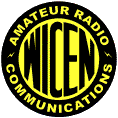

 |
 |
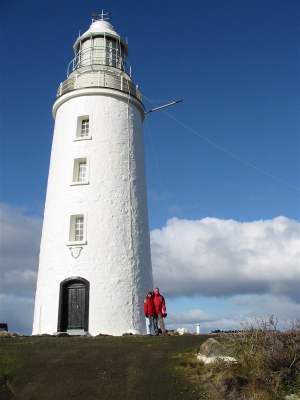
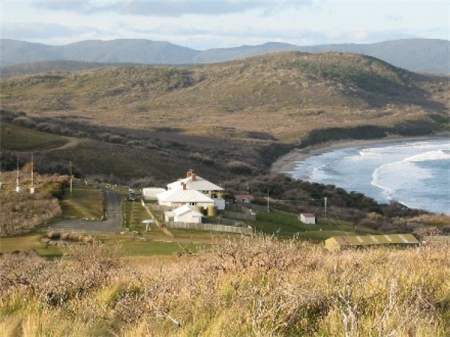 Met
at Cape Bruny by lighthouse caretaker Andy VK7WS, the group immediately set
to. One station was to be established at the keeper's cottage and
another at the lighthouse itself. Both stations were equipped with Icom
706's, one with an Icom AH-3 tuner. The cottage station was to have an
Off Centre Fed Dipole and at the lighthouse, a longwire from Peter's Land
Cruiser to the top of the lighthouse. Now came the interesting bit.
A gale was blowing - gusting to over 70 knots, that's 130 kilometres per hour
or, in the old money, over 80 miles per hour.
Met
at Cape Bruny by lighthouse caretaker Andy VK7WS, the group immediately set
to. One station was to be established at the keeper's cottage and
another at the lighthouse itself. Both stations were equipped with Icom
706's, one with an Icom AH-3 tuner. The cottage station was to have an
Off Centre Fed Dipole and at the lighthouse, a longwire from Peter's Land
Cruiser to the top of the lighthouse. Now came the interesting bit.
A gale was blowing - gusting to over 70 knots, that's 130 kilometres per hour
or, in the old money, over 80 miles per hour.
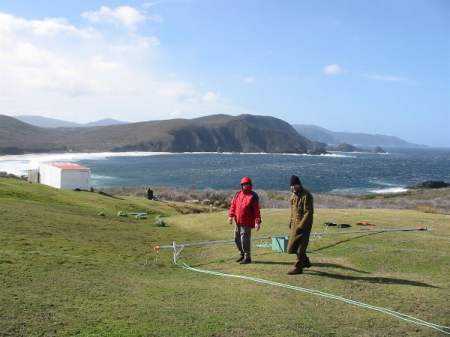 A
three section 9 metre aluminium mast with two sets of guys was raised close to
the site of the original mast near the cottages. Unfortunately, one pair
of guys was not adequately held on to as the mast was raised. Now - 7mm
polypropylene rope attached to a point 9 metres above the ground in a 130
kilometre per hour breeze adopts a horizontal attitude. A person of a
nominal height of something under two metres can only stretch so far.
The ensuing antics were greatly appreciated by a group of Japanese visitors.
Their shrieks of laughter are clearly audible on the video tape shot by Rhonda
and commissioned by the ATV group. The oriental mirth was doubled when
the local friendly possums ambled over to see what all the fuss was about.
A
three section 9 metre aluminium mast with two sets of guys was raised close to
the site of the original mast near the cottages. Unfortunately, one pair
of guys was not adequately held on to as the mast was raised. Now - 7mm
polypropylene rope attached to a point 9 metres above the ground in a 130
kilometre per hour breeze adopts a horizontal attitude. A person of a
nominal height of something under two metres can only stretch so far.
The ensuing antics were greatly appreciated by a group of Japanese visitors.
Their shrieks of laughter are clearly audible on the video tape shot by Rhonda
and commissioned by the ATV group. The oriental mirth was doubled when
the local friendly possums ambled over to see what all the fuss was about.
After some delay, a short lull allowed the wayward guy to be captured and
secured, enabling the antenna installation to proceed. A ring placed
around a guy on a supersonic anemometer mast rode up the guy, raising one end
of the OCF Dipole, the other being attached to a lanyard on our mast and
raised to position. Unfortunately the antenna ran above the cottage iron
roof which, together with a relatively low height, disabled its use on 80m and
reduced its effectiveness on other bands.
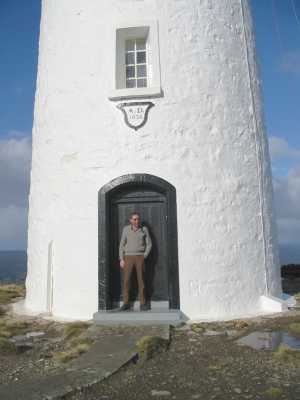 Next
came lunch to replenish the energy dissipated in the gale. Adequately
re-energised, Peter set off up the hill with Andy to the lighthouse to fix the
longwire. Andy went up the tower to rig a pulley and lower a halyard to
Peter at the bottom. Bitter earlier experience taught Peter to hang a
large shifter on the halyard to ensure it's descent. However, Peter was
to experience further difficulties. The plus 70 knot gale was measured
at the anemometer adjacent to the cottages. The lighthouse is somewhat
higher and more exposed, so the strength of the wind can only have been
greater. All Peter had to do was to wait at the base of the lighthouse
whilst Andy lowered the shifter weighted halyard to him. Now -
lighthouses tend to be liberally coated with paint. Paint is smooth and
provides little grip for a slimly built wind blown Amateur. Fortunately
for Peter, as he was slowly blown around the lighthouse base, he came upon the
recessed doorway which gave him some purchase and prevented him joining the
nearby pair of wedge-tailed eagles enjoying the blow.
Next
came lunch to replenish the energy dissipated in the gale. Adequately
re-energised, Peter set off up the hill with Andy to the lighthouse to fix the
longwire. Andy went up the tower to rig a pulley and lower a halyard to
Peter at the bottom. Bitter earlier experience taught Peter to hang a
large shifter on the halyard to ensure it's descent. However, Peter was
to experience further difficulties. The plus 70 knot gale was measured
at the anemometer adjacent to the cottages. The lighthouse is somewhat
higher and more exposed, so the strength of the wind can only have been
greater. All Peter had to do was to wait at the base of the lighthouse
whilst Andy lowered the shifter weighted halyard to him. Now -
lighthouses tend to be liberally coated with paint. Paint is smooth and
provides little grip for a slimly built wind blown Amateur. Fortunately
for Peter, as he was slowly blown around the lighthouse base, he came upon the
recessed doorway which gave him some purchase and prevented him joining the
nearby pair of wedge-tailed eagles enjoying the blow.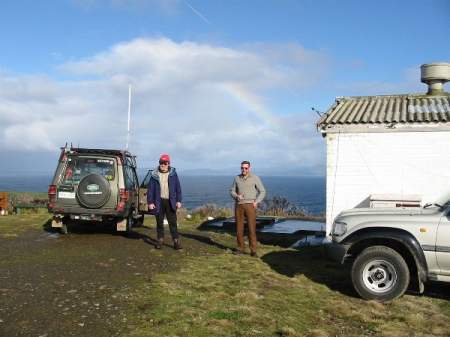 Our
description of the weather conditions we were experiencing brought little
sympathy. VK2 stations took great pleasure in telling us of their
temperatures in the high twenties and calm conditions.
Our
description of the weather conditions we were experiencing brought little
sympathy. VK2 stations took great pleasure in telling us of their
temperatures in the high twenties and calm conditions.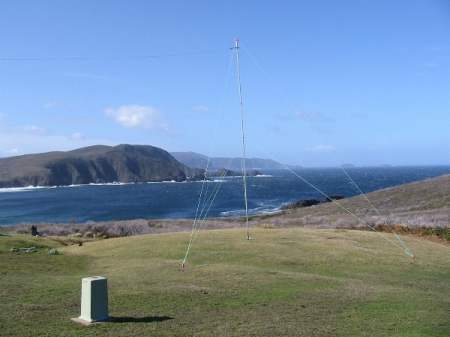
A few more contacts before breakfast, then a break to do a live cross-over for the VK7 Sunday morning broadcast from the lighthouse.
Unfortunately, the ferry was calling and we had to leave - but not before Andy
had shown us the beginnings of the Cape Bruny museum, including a standard
lighthouse issue Bendix transceiver transferred from WWII bomber duties.
We also viewed the new diesel generator, battery bank and inverter which
powers the station
- though not the current solar powered Cape Bruny light.
A quick trip to inspect the the top of the lighthouse, in the now calmer conditions, and to recover our halyard pulley, concluded our introduction to the International Lighthouse/Lightship Weekend - highly recommended to the stay at homes for next year. However, take your lead boots and hang on to those guy ropes!